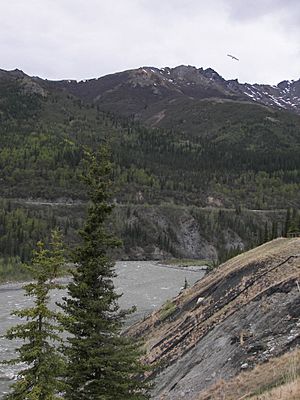Nenana Valley facts for kids

Overlook of the Nenana Valley
|
|
| Location | Nenana Valley, Alaska |
|---|---|
| History | |
| Founded | c. 11,000 BP |
| Cultures | Preceded the Clovis culture |
| Site notes | |
| Public access | Yes |
Nenana Valley is a very old archaeological site located in Alaska. Specifically, it's found in the Yukon-Koyukuk area. This special place helps us understand how people lived a long time ago, about 11,000 years ago! It is one of the earliest known sites in the Arctic part of North America.
Contents
Discovering the Ancient Nenana Valley
The Nenana Valley site gives us clues about the very first people who lived in North America. Scientists study the ground here to learn about their lives. They look at different layers of earth to see how old things are.
Life During the Ice Age
When people first came to Nenana Valley, it was during the end of the last Ice Age. This was a time when huge glaciers covered much of the world. The first people probably did not live here all year round. Instead, they traveled back and forth between North America and Asia. They might have used Nenana Valley as a temporary camp.
Scientists found animal bones at the site. These bones include mammoth and sheep. This tells us that people were hunting these animals. They likely followed the animals' paths as they moved with the seasons. This was a common way of life for hunter-gatherers.
From Nomads to Settlers
As the Ice Age slowly ended, the weather changed. The ice melted, and the land became warmer. Because of these changes, the Nenana Valley likely became a more permanent home for people. They might have stayed longer in one place as the environment became more stable.
Tools and Connections
Archaeologists have found special stone tools at Nenana Valley. These tools are called "points." They were likely used on the ends of spears for hunting. The points found here look similar to tools from a culture called Clovis culture. The Clovis culture is famous for its unique spear points found across North America.
The tools from Nenana Valley suggest that the people who lived there might have been ancestors to the Clovis people. This means the Nenana Valley culture could have come before the Clovis culture. Studying these tools helps scientists connect different ancient groups across North America.

